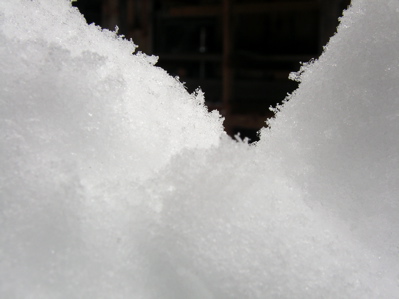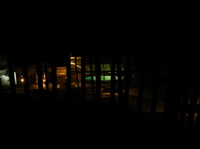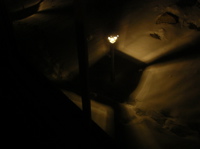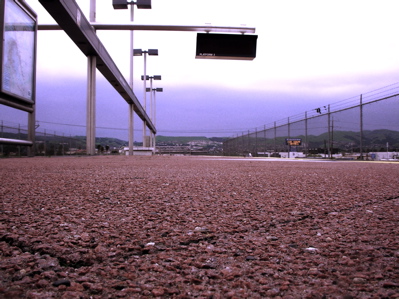14 March 2005 to 15 February 2005
¶ the last ten hours · 9 March 2005
Just because I can, here's the last ten hours of music iTunes has played me.
| # | Artist | Song | Time |
| 1 | Garnet Crow | 忘れ咲き | 4:58 |
| 2 | スピッツ | ほのほ | 4:18 |
| 3 | Feel So Bad | KALLO-KALLO-KALLO | 3:39 |
| 4 | Trans Am | Outmoder | 3:42 |
| 5 | Miller, Scott | Fairest of the Seasons | 3:38 |
| 6 | Zeppet Store | エヴリィ | 4:36 |
| 7 | Darling, Julia | Blue | 4:03 |
| 8 | Feel So Bad | 今日はクリスマス | 3:20 |
| 9 | Breeders | Cannonball | 3:33 |
| 10 | Stretch Princess | Angels | 5:00 |
| 11 | Whitley, Chris | Cool Wooden Crosses | 2:44 |
| 12 | Amos, Tori | Concertina | 3:56 |
| 13 | Amos, Tori | Lust | 3:53 |
| 14 | Feel So Bad | ENDORPHINE | 4:00 |
| 15 | My Bloody Valentine | Nothing Much To Lose | 3:17 |
| 16 | Production Club | Man on the Scene (feat. the Incredible Moses Leroy) | 3:30 |
| 17 | Runrig | Day Of Days | 3:37 |
| 18 | Fake? | Drip | 4:56 |
| 19 | Feel So Bad | 愛しているのに | 3:42 |
| 20 | HIM | Love You Like I Do | 5:14 |
| 21 | Siam Shade | 1/3 の純情な感情 | 3:44 |
| 22 | Suran Song in Stag | No Don't Stop | 3:52 |
| 23 | Siam Shade | アドレナリン | 4:28 |
| 24 | Amos, Tori | Cloud on My Tongue | 4:43 |
| 25 | Field Mice | Clearer | 3:54 |
| 26 | Fredriksson, Marie | Vidare igen | 3:28 |
| 27 | Moore, Abra | I Win | 4:22 |
| 28 | Garnet Crow | 夕月夜 | 4:15 |
| 29 | Sarge | Stall (Live) | 3:26 |
| 30 | New Pornographers | Chump Change | 4:18 |
| 31 | Amos, Tori | Cruel | 4:07 |
| 32 | Utada Hikaru | Animato | 4:31 |
| 33 | Fiona | In My Blood | 4:09 |
| 34 | Gackt | Lust for blood | 5:11 |
| 35 | Feel So Bad | グレチャウゾ | 4:56 |
| 36 | Radiohead | A Wolf At The Door -It Girl, Rag Doll- | 3:21 |
| 37 | HIM | Rebel Yell (Live) | 5:13 |
| 38 | 元ちとせ | 凛とする -strings version- | 4:51 |
| 39 | Glay | アイ | 3:56 |
| 40 | Do As Infinity | 菜ノ花畑 | 3:36 |
| 41 | Feel So Bad | 今夜はおしゃれをして | 3:59 |
| 42 | BUMP OF CHICKEN | 夢の飼い主 | 4:49 |
| 43 | Douglas Fir | At the Hotel | 2:59 |
| 44 | Leo, Ted / Pharmacists | The One Who Got Us Out | 3:04 |
| 45 | Low | I Started A Joke | 4:28 |
| 46 | Twigs | Slumber | 2:44 |
| 47 | Feel So Bad | Deeper | 2:42 |
| 48 | Feel So Bad | オーブントースター | 3:17 |
| 49 | 矢井田瞳 | 明日からの手紙 | 4:50 |
| 50 | Frames | Sickbeds | 4:12 |
| 51 | Corrs | Summer Sunshine | 2:53 |
| 52 | pillows | Plastic Flower | 4:11 |
| 53 | Big Country | Perfect World | 3:16 |
| 54 | brilliant green | Wishing You | 3:02 |
| 55 | Supercar | Love Forever | 4:11 |
| 56 | Ladysmith Black Mambazo | Wangibambezela | 4:59 |
| 57 | Martin, Charlotte | Parade On | 4:15 |
| 58 | HIM | In Joy And Sorrow | 3:35 |
| 59 | Siam Shade | Love Vampire | 4:39 |
| 60 | Sarge | Detroit Star-Lite | 3:33 |
| 61 | Feel So Bad | 今日は今日、気ままに | 3:00 |
| 62 | Mandalay | You Forget | 5:04 |
| 63 | Sarge | Dear Josie, Love Robyn | 3:01 |
| 64 | Primitons | City People | 3:32 |
| 65 | Amos, Tori | Parasol | 3:54 |
| 66 | Amos, Tori | Sweet The Sting | 4:16 |
| 67 | Amos, Tori | The Power of Orange Knickers | 3:36 |
| 68 | Amos, Tori | Jamaica Inn | 4:03 |
| 69 | Amos, Tori | Barons of Suburbia | 5:21 |
| 70 | Amos, Tori | Sleeps with Butterflies | 3:36 |
| 71 | Amos, Tori | General Joy | 4:13 |
| 72 | Amos, Tori | Mother Revolution | 3:58 |
| 73 | Amos, Tori | Ribbons Undone | 4:30 |
| 74 | Amos, Tori | Cars and Guitars | 3:45 |
| 75 | Amos, Tori | Witness | 6:06 |
| 76 | Amos, Tori | Original Sinsuality | 2:02 |
| 77 | Amos, Tori | Ireland | 3:49 |
| 78 | Amos, Tori | The Beekeeper | 6:50 |
| 79 | Amos, Tori | Martha's Foolish Ginger | 4:22 |
| 80 | Amos, Tori | Hoochie Woman | 2:34 |
| 81 | Amos, Tori | Goodbye Pisces | 3:36 |
| 82 | Amos, Tori | Marys of the Sea | 5:11 |
| 83 | Amos, Tori | Toast | 3:42 |
| 84 | New Model Army | Brother | 5:58 |
| 85 | New Model Army | Higher Wall | 4:22 |
| 86 | New Model Army | Flying Through the Smoke | 3:13 |
| 87 | New Model Army | You Weren't There | 3:36 |
| 88 | New Model Army | Orange Tree Roads | 3:56 |
| 89 | New Model Army | Someone Like Jesus | 6:36 |
| 90 | New Model Army | Stranger | 3:35 |
| 91 | New Model Army | R&R | 3:37 |
| 92 | New Model Army | Snelsmore Wood | 4:14 |
| 93 | New Model Army | Paekakariki Beach | 4:43 |
| 94 | New Model Army | Christian Militia | 3:25 |
| 95 | New Model Army | Notice Me | 2:38 |
| 96 | New Model Army | Smalltown England | 3:21 |
| 97 | New Model Army | Vengeance | 4:06 |
| 98 | Ida | Laurel Blues | 4:50 |
| 99 | Ida | 599 | 5:29 |
| 100 | Ida | Late Blues | 5:24 |
| 101 | Ida | Mine | 5:31 |
| 102 | Ida | What Can I Do | 2:57 |
| 103 | Ida | The Details | 4:38 |
| 104 | Ida | Sundown | 6:42 |
| 105 | Ida | Written On My Face | 3:50 |
| 106 | Ida | The Morning | 7:30 |
| 107 | Ida | Forgive | 7:31 |
| 108 | Garnet Crow | 夏の幻 | 3:55 |
| 109 | Tullycraft | Wild Bikini | 2:34 |
| 110 | Trembling Blue Stars | Helen Reddy | 4:25 |
| 111 | Springfield, Rick | Hole In My Heart | 3:12 |
| 112 | September When | When I Drive | 2:18 |
| 113 | Lucksmiths | Moving | 2:51 |
| 114 | Lucksmiths | Transportine | 4:11 |
| 115 | Frames | Revelate | 4:33 |
| 116 | Zeppet Store | INNOCENCE | 3:55 |
| 117 | HIM | Wicked Game (666-Remix) | 3:54 |
| 118 | Amos, Tori | Hey Jupiter | 5:11 |
| 119 | Manic Street Preachers | Solitude Sometimes Is | 3:21 |
| 120 | Siam Shade | 素顔のままで | 4:26 |
| 121 | mcdonald, glenn | Confetti Beams | 3:03 |
| 122 | Keene, Tommy | Disarray | 3:07 |
| 123 | Aberdeen | Emma's House | 3:56 |
| 124 | New Pornographers | The Laws Have Changed | 3:26 |
| 125 | Into Eternity | Beginning Of The End | 4:39 |
| 126 | スピッツ | みそか | 4:37 |
| 127 | Utada Hikaru | Exdous '04 | 4:32 |
| 128 | Frames | Fake | 3:59 |
| 129 | Manda and the Marbles | Upside Down | 3:18 |
| 130 | Low | California | 3:23 |
| 131 | Blue Nile | I Love This Life | 4:04 |
| 132 | Manic Street Preachers | No Jubilees | 3:44 |
| 133 | Wedding Present | Ringway to SEATAC | 2:43 |
| 134 | Ida | Honeyslide | 3:37 |
| 135 | Gackt | 精一杯のサヨナラ | 4:44 |
| 136 | Gackt | Tea Cup | 5:28 |
| 137 | Gackt | Etude | 6:24 |
| 138 | Gackt | ありったけの愛で〜Llv〜 | 5:36 |
| 139 | Gackt | ピース | 4:12 |
| 140 | Gackt | この夜が終わる前に | 4:58 |
| 141 | Gackt | 君に逢いたくて | 5:33 |
| 142 | Gackt | Dears〜LLV〜 | 6:58 |
| 143 | Gackt | サクラソウ | 2:42 |
| 144 | Gackt | Love Letter | 4:55 |
Spitz: Misoka (3.2M mp3)
This week this seems like the quintessential rock song to me. And it's only more quintessential if you don't speak the language.
This week this seems like the quintessential rock song to me. And it's only more quintessential if you don't speak the language.
¶ 8 March 2005
If nothing occurs to you, open the tiniest window to somewhere else.
¶ A Prayer for the Remain · 25 February 2005 fiction/poem
Stochastic in our causes, patriots in a republic of disingenuity, discarders of our angels, prophets of the silently unwound, we cede imbalance to inertia and the slow wind to the quickening hours. Give us reticence to the measure of our tolled waiting, and open ways that we may be escaped by the enchantments we helped tether. And we kneel in parted seas, shelter us with black clouds and the sinuous disenfranchisement of sand. When we stray from the islands of your tenuous grace, lead us to half-hatched disarray and limn our scars in the exhalations of convulsive repose. Give us panic for wakefulness, and tiny hatreds for eyes. Place our souls in the thick throats of lost doves, and our doubts in the deepest vaults of your sightless candor. Lead us to webs of dread and the shut exits of last year's mice, and let their thinset tremors smooth us as we diminish. We are the unmoved and the yet to know; we are the hollows of the bled and the disintegrated confidence of our practice. We are always here, and we are nowhere found.
So we are undone.
So we are undone.
I periodically find myself with small amounts of tabular data that I want to share, and hand-building HTML tables each time is tedious in repetition and awkward to instrument. I have finally amused myself by writing a simple server-side perl script that renders data from a csv file into an HTML table, and you are welcome to it if you have similar needs.
¶ 16 February 2005
1. This terrible town in which my employer is sub-headquartered has the tedious contours of a Sim City game played with dogged consistency in place of any shred of imagination. Numbingly uniform tiles snap together with cultivatedly anonymous diligence. The streets have individual names, but absolute characterlessness, and preferring one over another would be like having a favorite ounce of hypoallergenic hand lotion. If the question of whether there should be a picture-framing outlet every 2.79 miles or every 2.83 fascinates you, you'd love it here.
2. The wishful insistence that two numbers constitute a trend or an anomaly based on whether the second one is more or less desirable than the first.
And I'm still allowed to hate a third thing today, so the service at dinner better be good.
2. The wishful insistence that two numbers constitute a trend or an anomaly based on whether the second one is more or less desirable than the first.
And I'm still allowed to hate a third thing today, so the service at dinner better be good.
¶ 15 February 2005
I have decided to limit myself to disapproving of no more than three things each day. Today's are:
1. The pointless hubris of claiming superlative excellence in activities which should not be done at all.
2. Any article of clothing which appears to have been made from the pelts of characters in the original Planet of the Apes.
3. Coffee which is neither palatable without sugar, nor appreciably improved by it.
For the remainder of the day, I am at peace with all other folly.
1. The pointless hubris of claiming superlative excellence in activities which should not be done at all.
2. Any article of clothing which appears to have been made from the pelts of characters in the original Planet of the Apes.
3. Coffee which is neither palatable without sugar, nor appreciably improved by it.
For the remainder of the day, I am at peace with all other folly.




